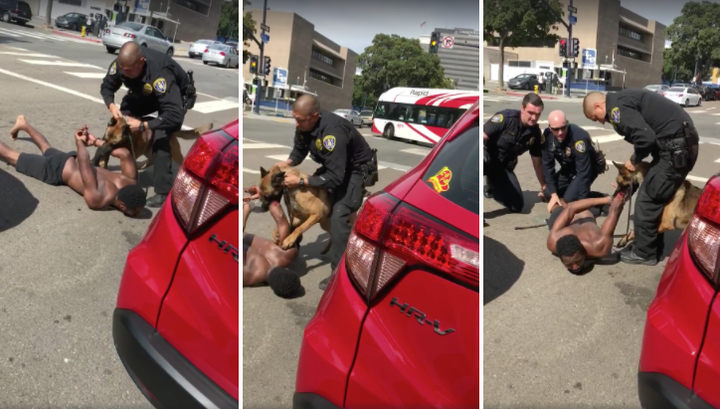
A passerby’s graphic video shows a San Diego police dog biting a handcuffed robbery suspect’s bloodied arm, refusing to release it, as the man lies screaming on the ground.
Angel Nunez, who posted two videos of the arrest on Facebook, said he had just left work when he saw the man being tackled by the dog. He said the dog’s police handler had “no control of his K-9.”
“Why can’t you call him off?” a man hollers at the officers in one of the videos. “Is he going to rip his arm off? What is going to happen to the guy?”
Police said they were called to the scene Sunday by reports of a man jumping on cars, running in traffic, attempting to remove stop signs and trying to fight passersby. Police said he punched a cab driver and tried to steal a motorcycle, the San Diego Tribune reported.
For at least 30 seconds, the German shepherd clamps down on the shirtless man’s arm as he screams in pain. The officer is seen tugging on the dog’s neck.
Another video shared by Nunez appears to show the suspect struggling with the officer before being tackled by the dog. The suspect, with the dog on him, then follows the officer’s order to get on the ground and show his hands.
Police described the man’s injuries as minor. He was identified by NBC San Diego as Jeremai Northard. Police charged him with robbery, attempted theft and being under the influence of drugs.
Some viewers of the videos, commenting on Facebook, accused the officer of egging the dog on by squeezing its neck. Others said the officer failed to command the dog to release the man.
But that’s not how San Diego’s police dogs are trained, the department said.
Police K-9s are not taught to release on a verbal command. Instead, officers apply pressure to the dog’s jaw, which doesn’t work right away, San Diego police Lt. Scott Wahl told the Union-Tribune.
“Sometimes it takes a bit to get into the right position,” Wahl said. “It’s not a perfect, sterile environment where you push a button and it happens.”
Though the bite may be painful, Wahl said the clamping method prevents suspects from receiving multiple bites “up and down the arm,” according to 10 News.
“If it’s one second, five seconds, or 15 seconds, if the dog is biting and holding like he’s trained to do, then the injuries that are inflicted immediately are no different 15 seconds later,” Wahl told the station.
Not all U.S. police dogs are trained with physical commands. The U.S. Police Canine Association, which touts itself as the oldest and largest K-9 certifying group in the country, requires that dogs learn a verbal release command, David Ferland, the group’s national executive director, told HuffPost.
“We have 2,900 police dogs that certify with us and they are all required to have verbal control,” Ferland said. He added that he didn’t know why San Diego would train its police dogs with physical commands rather than verbal ones.
